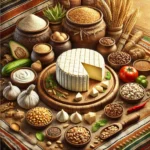Afghanistan is a land of rugged mountains, fertile valleys, and centuries-old pastoral traditions. Among the many culinary treasures born from this landscape, Afghan yogurt cheese stands out as a symbol of simplicity, nourishment, and cultural heritage. Made from strained yogurt, this cheese—known in different regions as chakah, qurut, or labneh-style cheese—is deeply rooted in Afghan food culture. Revered for its tangy flavor, creamy-to-firm texture, and long shelf life, Afghan yogurt cheese reflects the resourcefulness of rural dairy practices in a country where milk preservation has always been essential.
This comprehensive guide explores the origins, production methods, taste profile, cultural significance, modern uses, pairings, and more—offering an in-depth understanding of Afghanistan’s traditional yogurt-based cheese.
🧀 What Is Afghan Yogurt Cheese?
Afghan yogurt cheese is a strained yogurt product that can range from:
-
soft and creamy (similar to labneh)
-
firm and rollable (shaped into balls)
-
hard and dry (known as qurut, used as a long-lasting food)
Its form depends on how long the yogurt is strained and how it is prepared afterward.
Key Characteristics
| Feature | Description |
|---|---|
| Base | Cow, goat, or sheep yogurt |
| Texture | Soft, semi-firm, or hard |
| Flavor | Tangy, savory, slightly acidic |
| Color | White to off-white |
| Shelf Life | Days to months (depending on preparation) |
| Use | In sauces, soups, spreads, snacks |
Afghan yogurt cheese is prized for its versatility, nutritional value, and delightful sourness—perfect for the country’s bold, spice-forward dishes.
🌄 Origins & Cultural Significance
Afghanistan’s geography has shaped a pastoral lifestyle reliant on livestock, especially cattle, goats, and sheep. Yogurt, buttermilk, and cheese are central to Afghan cuisine, and the need to make dairy shelf-stable has inspired various fermented and dried dairy products.
Cultural Importance
-
Preservation: Hard yogurt cheese (qurut) can last months and sustain families during winter or travel.
-
Nutrition: Rich in protein, calcium, and probiotics.
-
Tradition: Passed down through generations of women who perfected home cheesemaking techniques.
-
Cuisine: A key ingredient in iconic Afghan dishes such as aashak, mantu, and aush.
In Afghan villages, yogurt cheese is more than food—it is a link to ancestral knowledge and a reflection of pastoral ingenuity.
🥛 How Afghan Yogurt Cheese Is Made
While each region has its own variations, the basic process remains simple and natural.
⭐ 1. Making the Yogurt
Fresh milk (cow, goat, or sheep) is boiled, cooled, and inoculated with a yogurt starter. Once set, the thick, tangy yogurt becomes the base for the cheese.
⭐ 2. Straining the Yogurt
The yogurt is placed in:
-
muslin cloth
-
cheesecloth
-
fine woven sacks
It hangs for several hours—or even overnight—to drain whey.
The longer the strain, the firmer the cheese.
⭐ 3. Salt Addition (Optional)
For longer storage, salt is mixed into the strained yogurt.
⭐ 4. Shaping the Cheese
Depending on the desired style, the cheese may be:
-
left soft and creamy
-
shaped into small balls
-
pressed into discs and sun-dried to harden into qurut
⭐ 5. Drying (for Qurut)
The hardened cheese balls are dried under the sun, producing a product that can last for months and be crumbled into soups and sauces.
This simple yet masterful method preserves dairy using natural Afghan conditions.
🧂 Varieties of Afghan Yogurt Cheese
⭐ 1. Chakah
-
Soft, creamy, spreadable
-
Similar to labneh
-
Used as a dip or topping
⭐ 2. Qurut
-
Hard, dried yogurt cheese balls
-
Shelf-stable for months
-
Rehydrated for soups such as aush
⭐ 3. Labneh-style Afghan Cheese
-
Semi-firm, tangy, rich
-
Rolled into balls and stored in olive oil or salt
Each variety has a unique texture and culinary purpose.
🧂 Taste & Texture Profile
Afghan yogurt cheese is known for its bold tang and rich creaminess.
Flavor Notes
-
pleasantly sour
-
creamy and fresh
-
slightly salty (if salted)
-
earthy, especially in goat and sheep versions
Texture
-
soft and velvety (fresh chakah)
-
firm and spreadable (labneh balls)
-
chalky and hard (qurut)
Because it is naturally fermented, the cheese develops complex aromas typical of traditional Afghan dairy foods.
🍽 Culinary Uses in Afghan Cuisine
Afghan yogurt cheese is extremely versatile and used across everyday meals and special dishes.
⭐ 1. As a Dip or Spread
Soft yogurt cheese is served with:
-
naan
-
flatbreads
-
herbs and cucumbers
-
olive oil and spices
⭐ 2. In Afghan Soups & Sauces
Qurut is dissolved in water to make a tangy, creamy base for:
-
aush (noodle soup)
-
aashak (dumplings)
-
mantu (steamed meat dumplings)
Its acidity cuts through richness and enhances flavor.
⭐ 3. With Rice Dishes
It pairs beautifully with:
-
pilaf
-
kabuli pulao
-
herb rice
⭐ 4. In Modern Fusion Cuisine
Chefs now use Afghan yogurt cheese in:
-
wraps
-
salads
-
burgers
-
mezze platters
-
grain bowls
Its tang elevates both traditional and contemporary dishes.
⭐ 5. As a Healthy Snack
Rolled into small balls or eaten fresh with:
-
nuts
-
fruits
-
honey
-
dried herbs
🥂 Best Pairings
Food Pairings
| Food | Why it Works |
|---|---|
| Naan & flatbreads | smooth texture complements soft bread |
| Lentils | acidity balances earthy legumes |
| Kabobs | cuts through richness |
| Herbs & cucumbers | refreshing contrast |
| Rice dishes | creamy complement |
Beverage Pairings
-
mint tea
-
black tea
-
ayran (yogurt drink)
-
light white wines (optional)
-
sparkling water
🧊 Storage & Shelf Life
Soft yogurt cheese (chakah)
-
refrigerate
-
lasts 3–5 days
-
keep in sealed container
Labneh-style balls
-
stored in olive oil or salted whey
-
lasts 2–3 weeks
Qurut (hard cheese)
-
lasts several months at room temperature
-
best kept dry
The long shelf life of qurut reflects the survival traditions of Afghanistan’s harsh environments.
🌍 Afghan Yogurt Cheese Compared to Similar Cheeses
| Cheese | Region | Similarity | Difference |
|---|---|---|---|
| Labneh | Middle East | strained yogurt | creamier, not dried into balls |
| Qurut/Kurut | Central Asia | dried yogurt cheese | Afghan version has stronger tang |
| Chakka | India | thick yogurt cheese | often sweeter and less tangy |
| Kefir cheese | Caucasus | cultured dairy | uses kefir grains instead of yogurt |
Afghan yogurt cheese stands apart for its distinct sourness and role in national dishes.
🌱 Modern Relevance & Global Interest
As global cuisine expands, Afghan dairy products are gaining attention in:
-
diaspora communities
-
specialty grocery stores
-
gourmet cooking
-
culinary tourism
Food enthusiasts appreciate Afghan yogurt cheese for its:
-
probiotic benefits
-
rich flavor
-
versatility
-
artisanal, heritage-driven production
Restaurants specializing in Central and Middle Eastern cuisine now highlight chakah and qurut on their menus.
⭐ Conclusion
Afghan yogurt cheese is a remarkable fusion of tradition, necessity, and culinary artistry. Whether enjoyed fresh, rolled, or dried into qurut, it reflects the resilience and creativity of Afghan food culture. Its tangy flavor, nutritious qualities, and wide range of uses make it a standout dairy product not only in Afghanistan but increasingly around the world.
As more people discover the rich tapestry of Afghan cuisine, yogurt cheese remains a delicious gateway into the country’s traditions—simple yet profound, familiar yet unique.
FAQs – Afghan Yogurt Cheese
1. What is Afghan yogurt cheese made from?
It is made from strained yogurt, typically from cow, goat, or sheep milk.
2. What is qurut?
A hard, dried form of Afghan yogurt cheese used in soups and traditional dishes.
3. How is Afghan yogurt cheese eaten?
As a dip, in sauces, with rice dishes, in dumplings, or as a snack.
4. Does Afghan yogurt cheese spoil quickly?
Soft versions last a few days refrigerated; dried qurut can last months.
5. Is Afghan yogurt cheese healthy?
Yes—rich in probiotics, protein, and calcium, with minimal processing.



